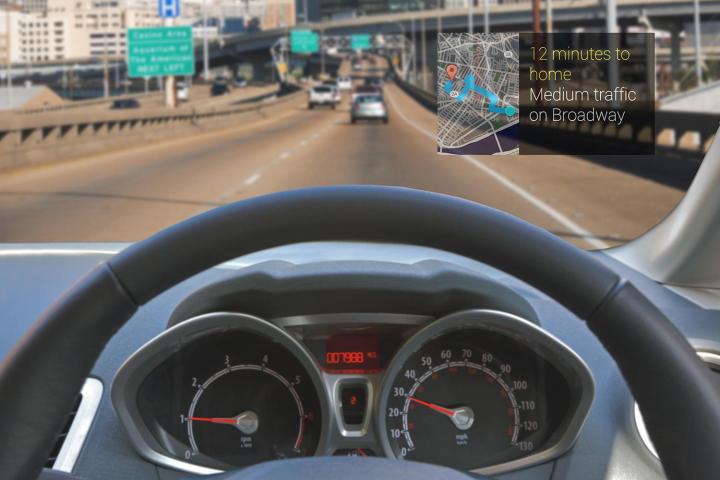
Yesterday, the UK Department for Transport announced that it is banning drivers from using Google Glass. Yep, though it probably won’t go on sale for at least a year, yet another institution has banned Google’s first eyewear. (Don’t try to go to this casino or this bar. They don’t take kindly to Glassers…) But, seriously. What’s the deal? Are an abnormal number of Glassholes driving around English streets already? Are all members of the Department for Transport Apple fans or something? This is the most shortsighted and ridiculous ban I’ve seen in a while.
Here’s what a DFT spokesperson told Stuff and The Telegraph about the ban:
“It is important that drivers give their full attention to the road when they are behind the wheel and do not behave in a way that stops them from observing what is happening on the road. A range of offenses and penalties already exist to tackle those drivers who do not pay proper attention to the road including careless driving which will become a fixed penalty offense later this year. We are aware of the impending rollout of Google Glass and are in discussion with the Police to ensure that individuals do not use this technology while driving.”
If we’re banning distracting activities, we should outlaw car passengers.
I don’t say this often, but “screw you” UK Department for Transport. This is a dumb ban.
I’ve used Glass, and I’ve mingled with 2,000 people wearing Glass. Sure, it’s a little strange, but I wouldn’t mind if they were driving. In fact, Glass might be one of the safest new technologies to enter the car in some time.
Wearing Glass is not distracting. It sits on your face, requires virtually no physical interaction, and doesn’t block your vision. Its screen appears to float about a yard (or meter, you Brits) in front of your eye, in the upper right corner of your vision. It’s not big, it moves with your head (so you can easily move it out of the way), and you can see through it. And that’s when it’s on at all. Until you activate Glass, it sits idle and doesn’t project any display at all.
Communicating with Glass can be done without looking at anything. You can either talk to it by saying “OK Glass” or you can tap it with your right hand. How, exactly, is that unsafe?
In fact, Google Glass may be the most beneficial gadget to ever enter the vehicle.
The benefits of Glass are already clear. Glassy drivers can see the weather ahead, answer a call, learn the time, or get turn-by-turn navigation directions without taking their eyes off the road for a second.
Once Glass is out, developers will publish apps for almost every car function you can imagine. You could use glass to pick Spotify or Pandora music, change the radio station, play a podcast, call someone, change the volume, call OnStar, call AAA, charge your electric vehicle, check your engine for issues (when you open the hood), see your car’s rear view mirrors, and a thousand other tasks we can’t yet fathom.
Glass could revolutionize our efficiency in the car. Right now, we have to look away from the road to do absolutely everything, but not with Glass. With an eye-mounted smart device, important information could be routed into a tiny box in our peripheral vision and have voice control. That is something to embrace, not ban.
The average person blinks more than 15,000 times every 16 hours. Do you really want a bunch of distracted, blinking drivers on the streets?
If you want to ban Google Glass from being used inside a car, then you better ban dash-mounted phones, AM/FM radios, CD players, dash-mounted GPS units, air conditioning controls, fuel gauges, speed gauges, rear-view mirrors, and side mirrors. These activities are all probably more distracting than Glass.
And, honestly, if we’re banning distracting activities, we should outlaw car passengers. There’s nothing more distracting than a sack of flesh sitting next to you, yapping away while you’re trying to drive. We should also ban audio in the car; you can’t focus on the road if you’re jamming out to Daft Punk songs or listening to This American Life. It’s not safe.
You know, thinking about it, if we really want safe roads, we should force drivers to pop Aderall and guzzle down stimulating energy drinks so we can make sure they stay alert and awake. Actual eyewear like glasses and contacts are definitely not safe either, nor is anyone with impaired vision because they cannot wear their glasses or contacts. And we should probably tape their eyes open so they don’t blink. The average person blinks more than 15,000 times every 16 hours. Do you really want a bunch of distracted, blinking drivers on the streets?
OK, last idea: It might be best to get rid of human drivers entirely. If only some company would think of a way to do that.
Unless the UK Department for Transportation is ready to get rid of people entirely, they should start focusing on real threats, not theoretical gadgets that they don’t understand. Every time we keep someone from texting on a smartphone while driving is a life potentially saved. Google Glass is not a smartphone, but it may be exactly what finally makes smartphones safe to use in the car. Let’s not ban it before it has the chance.
(Images courtesy of Shutterstock, Inc.)
Editors' Recommendations
- I’m replacing my normal glasses with smart glasses. Here’s why
- Google Pixel 7a could add three huge features over the Pixel 6a
- Google is bringing its futuristic AR glasses to the real world … kind of
- 10 years on, Google Glass is still a Google I/O high point
- WhatsApp backups may soon count against Google Drive storage
